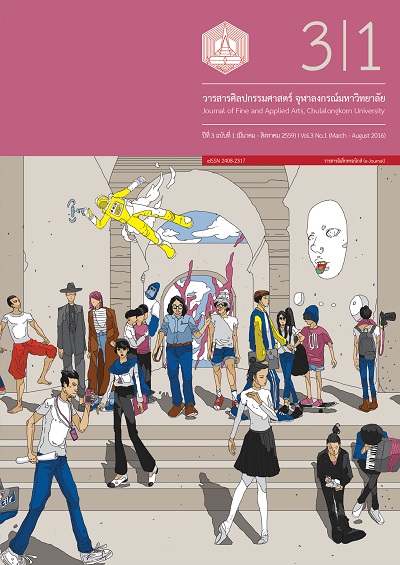วงดนตรีคณะหนุ่มเสียงพิณ ตำบลบ้านเลือก อำเภอโพธาราม จังหวัดราชบุรี
Keywords:
หนุ่มเสียงพิณพิณ, ลาวเวียง, อำเภอโพธาราม, จังหวัดราชบุรี, Noom Siang Pin, Lao Wiang, Phothamram District, Ratchaburi ProvinceAbstract
บทคัดย่อ
งานวิจัยเรื่อง “วงดนตรีคณะหนุ่มเสียงพิณตำบลบ้านเลือก อำเภอโพธาราม จังหวัดราชบุรี” มีวัตถุประสงค์เพื่อศึกษาบริบทของวงดนตรีลักษณะเครื่องดนตรี วิธีการบรรเลง บทบาทหน้าที่ และบทเพลงใช้ระเบียบวิธีวิจัยเชิงคุณภาพจากการศึกษาพบว่า กลุ่มชาติพันธุ์ลาวเวียงที่อาศัยอยู่ ณ ตำบลบ้านเลือก อำเภอโพธาราม จังหวัดราชบุรี ได้อพยพจากเวียงจันทน์มาอาศัยอยู่ในประเทศไทยตั้งแต่ปี พ.ศ. 2322 นำวัฒนธรรมการบรรเลงที่มีแคนเป็นเครื่องดนตรีดำเนินทำนองหลักผสมกับพิณ ปัจจุบันมีการเปลี่ยนแปลงพัฒนาการโดยนำเครื่องดนตรีสากลมาร่วมบรรเลงในปัจจุบันมีวงดนตรีในพื้นที่จำนวน 2 คณะ คือ “หนุ่มเสียงพิณ” และ “พรพระศิวะ” เครื่องดนตรีในวงประกอบด้วย แคน พิณ กลองพื้นเมือง ฉิ่ง ฉาบเล็ก ฉาบใหญ่ แคนที่ใช้ทำจากไม้ซาง ลิ้นเป็นโลหะ ปรากฏทั้งแคน 7 และแคน 8 หุ่นของกลองพื้นเมืองทำจากไม้มูก (ไม้จามจุรี) ขึ้นหน้ากลองด้วยหนังทั้ง 2 ด้าน เครื่องดนตรีสากลที่ใช้ได้แก่แซกโซโฟน เบส กลองใหญ่และกลองชุดชาวลาวเวียงนิยมนำวงดนตรีดังกล่าวไปบรรเลงในงานประเพณีและงานบุญ ได้แก่ ประเพณีกินดอง ประเพณีอุปสมบท ประเพณีแห่ดอกไม้ฉลองสงกรานต์ประเพณีบุญเดือนสิบสองงานลอยกระทง เป็นต้น
ผลการวิจัยพบว่า คีตลักษณ์ของทำนองแคนในวงดนตรีคณะหนุ่มเสียงพิณ ส่วนใหญ่เป็นเพลงท่อนเดียว มีการซ้ำทำนองพบเพลงหลายท่อนเป็นส่วนน้อยในเพลงทั่วไปพบว่ามีการใช้กลุ่มเสียงปัญจมูลเพียง 1 กลุ่ม หากเป็นเพลงที่ต้องใช้ทักษะขั้นสูงจะใช้ 2 กลุ่มเสียงและใช้เสียงนอกบันไดเสียงมาร่วมตกแต่งทำนองบ้าง โดยใช้แนววิถีทำนองแบบ “ลง-ขึ้น” มากที่สุด สำนวนการดำเนินทำนองเพลงมี 6 รูปแบบหลัก คือ การทอนทำนอง การเรียงเสียงลูกตกภายในวรรคเพลงอย่างเป็นระเบียบจากเสียงต่ำไปหาเสียงสูง การใช้โน้ต 3 พยางค์เสียงมาร่วมดำเนินทำนอง ซึ่งมักวางไว้ในตำแหน่งห้องเพลงเลขคู่และการใช้โน้ต 4 พยางค์เสียงต่อ 1 ห้องเพลงในตำแหน่งห้องเพลงเลขคี่ การย้ำเสียงเดิมซ้ำ ๆ กันภายใน 1 บรรทัด การไม่ใช้เสียงหลักของกลุ่มเสียงปัญจมูลได้แก่เสียงโดในการดำเนินทำนอง แต่ใช้เสียงอื่นโดยเฉพาะเสียงลา ซึ่งเป็นเสียงที่ 6 ของกลุ่มเสียง โด เร มี X ซอล ลา X มาเป็นเสียงลูกตกซึ่งแสดงถึงปรากฏการณ์ Pillar Tone และการใช้“กลอนฝาก” ระหว่างทำนองบรรทัดหนึ่งไปอีกบรรทัดหนึ่ง
Abstract
The sesearch entitled "Musical Ensemble Of Noom Siang Pin At Ban Lueak Sub-district Of Photharam District In Ratchaburi" is aimed to study relevant contexts: ensemble, musical instruments, playing style, roles and repertoire. Qualitative research methodology was employed. The study shows that Lao Wiang ethnic group at Ban Lueak sub-district, Photharam District, Ratchaburi Province, immigrated themselves from Vientiane to the northeasternpart of Thailand since 1779 A.C. They also brought the cultural music of playing "Noom Siang Pin" with Khaen and Pin as the main melodic instrument to the new settlement. At present the music ensemble of Noom Siang Pin was developed by adding the western musical instruments. There are two local bands in the area; "Pon Phra Shiva" and "Noom Siang Pin." The instruments in the band included Khaen, folk drum, Ching, small cymbals, large cymbals. Khaen was made up from Mai Sang with metal reeds. This instrument was usually played with 7 and 8 Khaen pipes. The body of a Folk drum was made from Mook wood (Eastindian walnut, Raintree)and stretched up both sides with membranes. Bass Guitar and Bass Drum were also found in the ensemble. The Lao Wiangs usually used this ensemble to accompany their annual festivals and ceremonies such as Kin Dong (matrimonial ceremony), Buddhist ordination, Hae Dok Mai (Flower parade in Songkran festival), Loy Krathong or Boon Duan Sip Song (Twelve’s lunar month festival).
The research findings show that Khaen's melodic forms in the Musical ensemble of Noom Siang Pin mostly fall into a single-section form. The repetitive melodies and the form of multiple sections were rarely found. The use of penta-centric scale was common and songs that required advanced skills may have two melodic modes which usually use the avoided pitches of mode for ornamentation by using the composition of "down-up" melodies mostly. The composed melodies have six main forms: melodic reduction; the downbeat note arrangement within phrases neatly ordered from low to high; the use of triplets often placed in the even measures and using four notes in the odd measures; an emphasis and repetition of one pitch within one line; avoiding the tonic, but using other notes especially the sixth degree in the penta-centric mode of Do (Do Re Me X So La X) as the downbeat note; a delay of melodic goal.
Downloads
Issue
Section
License
ลิขสิทธิ์ของบทความเป็นของเจ้าของบทความ บทความที่ได้รับการตีพิมพ์ถือเป็นทัศนะของผู้เขียน
กองบรรณาธิการไม่จำเป็นต้องเห็นด้วยและไม่รับผิดชอบต่อบทความนั้น






